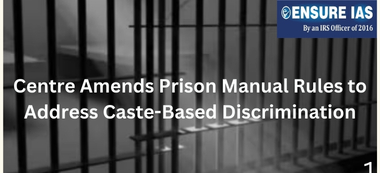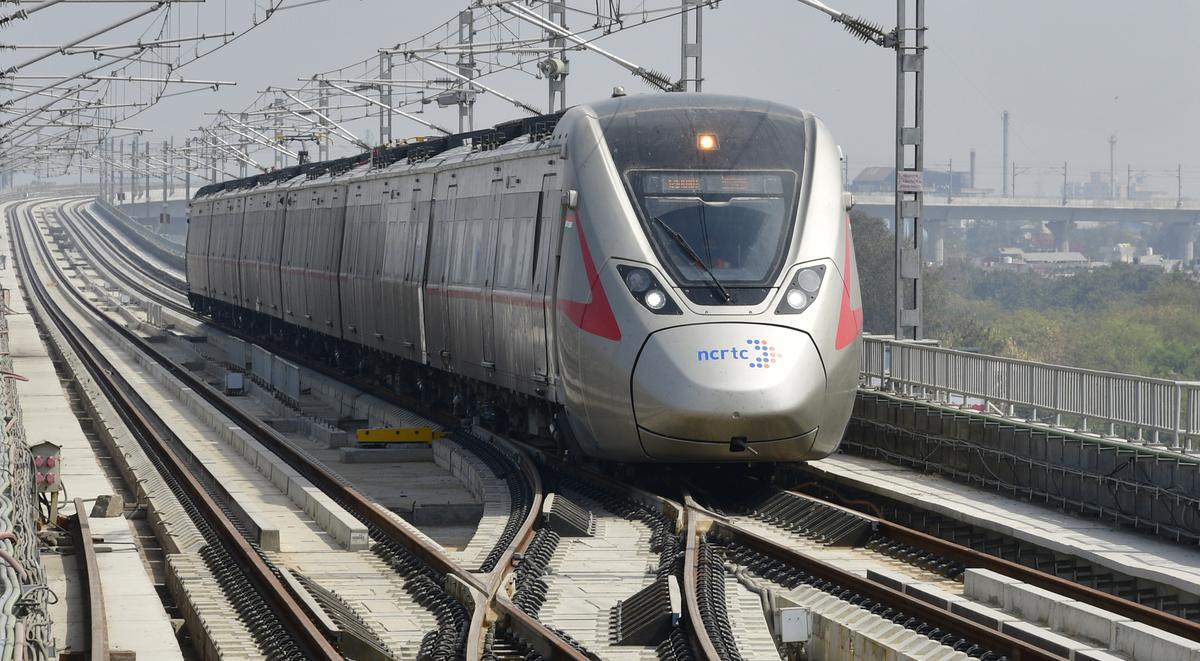- Courses
- GS Full Course 1 Year
- GS Full Course 2 Year
- GS Full Course 3 Year
- GS Full Course Till Selection
- Online Program
- GS Recorded Course
- NCERT (Recorded 500+ Hours)
- Polity Recorded Course
- Geography Recorded Course
- Economy Recorded Course
- AMAC Recorded Course
- Modern India, Post Independence & World History
- Environment Recoded Course
- Governance Recoded Course
- Science & Tech. Recoded Course
- International Relations and Internal Security Recorded Course
- Disaster Management Module Course
- Ethics Recoded Course
- Essay Recoded Course
- Current Affairs Recoded Course
- CSAT
- 5 LAYERED ARJUNA Mentorship
- Public Administration Optional
- ABOUT US
- OUR TOPPERS
- TEST SERIES
- FREE STUDY MATERIAL
- VIDEOS
- CONTACT US
Centre Amends Prison Manual Rules to Address Caste-Based Discrimination
Centre Amends Prison Manual Rules to Address Caste-Based Discrimination
02-01-2025

- On December 30, 2024, the Union Ministry of Home Affairs (MHA) made important changes to the Model Prison Manual, 2016 and the Model Prisons and Correctional Services Act, 2023.
- These changes aim to end caste-based discrimination in India’s prisons.
- The revisions were made after the Supreme Court’s order on October 3, 2024, which raised concerns about caste-based segregation in prisons and directed the Centre to take action.
Key Amendments:
A. Ban on Caste-Based Discrimination
- The new rules make it clear that prisoners cannot be discriminated against based on their caste.
- The changes prohibit the segregation or classification of prisoners by caste and ensure that caste does not affect how prisoners are assigned tasks or work in the prison.
- Prison officials must make sure that there is no caste-based discrimination in how duties or work are assigned.
- This includes ensuring that no prisoner gets a task or work solely because of their caste.
- This change directly addresses the Supreme Court’s concerns about caste-based practices, ensuring that all prisoners are treated equally, no matter their caste.
B. New Legal Framework – Section 55(A)
- Introduction of Section 55(A): A new section, 55(A), has been added to the Model Prisons and Correctional Services Act, 2023.
- This section specifically bans caste-based discrimination in prisons, making the prohibition official.
- Binding on All States and UTs: This rule is now binding on all states and Union Territories (UTs), ensuring that there is no caste discrimination in prisons across the country.
C. Ban on Manual Scavenging
- No Manual Scavenging in Prisons: The new rules also say that manual scavenging (the practice of cleaning sewers or septic tanks by hand) will not be allowed in any prison or correctional institution.
- This rule follows the Prohibition of Employment as Manual Scavengers and Their Rehabilitation Act, 2013.
- Upholding Dignity: The aim is to protect the dignity of prisoners and stop the inhumane practice of manual scavenging, which has historically been linked to people from lower castes.
D. Habitual Offenders: Revised Definition
- Revised Habitual Offender Definition: The MHA has changed the definition of habitual offenders in the Model Prison Manual and the Model Prisons and Correctional Services Act. The new definition is:
- A habitual offender is someone who, during a continuous 5-year period, has been convicted and sent to prison more than twice for different crimes that are not part of the same event.
- Jail Time Exclusion: Time spent in jail, either under a sentence or in detention, is not counted in the five-year period.
- Reason for Change: The MHA made this change because many states and UTs have not passed a Habitual Offenders Act, leading to confusion over how habitual offenders should be treated.
Role of the Supreme Court:
The Supreme Court’s ruling on October 3, 2024 played an important role in pushing the government to make these changes. The Court:
- Raised concerns about caste-based discrimination in prisons, particularly regarding how prisoners are categorized and assigned work.
- Directed the Centre and state governments to update prison rules to match constitutional principles of equality and non-discrimination.
- The Court also focused on the issue of habitual offenders and ordered that states should update their prison rules to reflect this definition. If any state does not have a Habitual Offenders Act, they were given three months to make the changes.
Impact of the Amendments:
- These changes aim to make India’s prisons a fairer and more equal place for all prisoners, especially for those from marginalized caste groups.
- The changes will help ensure that prisoners are not treated unfairly based on their caste.
- The amendments aim to protect the basic rights of prisoners, especially for those from the Scheduled Castes (SC) and Scheduled Tribes (ST), ensuring they are not discriminated against based on caste.
- The ban on manual scavenging in prisons is crucial for ending this degrading practice, which is linked to lower caste communities, especially the SC/ST groups.
- The changes make sure that the rules for treating habitual offenders are the same across India.
- States that do not have a Habitual Offenders Act will need to make their laws fit with the new rules.
Time Frame and Compliance:
- 3-Month Deadline: States and Union Territories must update their prison rules within three months to follow the new amendments, especially regarding the Habitual Offenders Act.
- Ensuring Compliance: The Centre has asked the Home Ministry to make sure these changes are properly implemented and monitored to ensure there is no caste-based discrimination in prisons.
Prison Reforms in India:1. Prison Administration
2. Key Reforms
3. Financial Assistance and Technological Support
4. Mental Health and Legal Aid
5. Key Directives: Under-Trial Review: Following a Supreme Court order, the National Legal Services Authority Standard Operating Procedure for Under-Trial Review Committees has been circulated to all states and Union Territories to speed up the review process for individuals held without trial |
|
Also Read |
|


